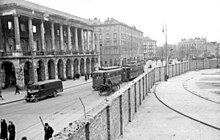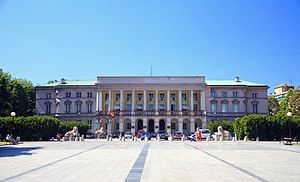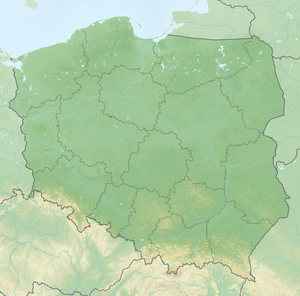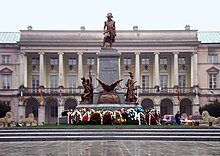Lubomirski Palace (Warsaw)
| Lubomirski Palace | ||
|---|---|---|
|
Front (east) on today's Żelaznej Bramy Square |
||
| Creation time : | after 1800 | |
| Castle type : | palace | |
| Conservation status: | Reconstructed | |
| Place: | Warsaw | |
| Geographical location | 52 ° 14 '22.7 " N , 21 ° 0' 4.3" E | |
|
|
||


The Lubomirski Palace , the seat of an employers' association, which is now classicistically designed , is located in the historically significant Za Żelazną Bramą district in downtown Warsaw . In the 300 years of its existence, it served many purposes and was often rebuilt. In addition to its historical significance, the relocation of the entire building in 1969 is particularly noteworthy.
history
The exact date of construction of the original building is not known. At the end of the 17th century, a representative of the wealthy Radziwiłł family bought part of the area north of the then city (Wielopole). A palace is mentioned for the first time in 1712 at this point. Around 1730 the palace was owned by the architect Johann Sigmund Deybel . At the end of the 1730s, Prince Stanislaw Wincenty Jabłonowski is named as the owner of the property. It is assumed that Prince Antoni Lubomirski bought the property from him around the middle of the 18th century .
The palace under the Lubomirskis
In 1760 work began on rebuilding the palace in the late Baroque style based on a design by Jakub Fontana . The renovation was not completed; In 1779 Bernardo Bellotto painted the unfinished palace. After Prince Aleksander Lubomirski became the owner of the palace and the surrounding area in 1790, he continued the renovation and modernization of the building. Jakub Hempel designed a magnificent portico for the palace, which is now designed in the classical style , which rests on ten Ionic columns and an arcade foundation. Until the Teatr Wielki was built, it was the largest colonnade in Warsaw. The side wings flanking the Cour d'honneur were also enlarged.
In 1803 Lubomirski's daughter Rozalie inherited the palace. She sold it to General Izydor Krasinski in 1816 .
The decline
From 1828 to 1834 the palace was owned by the Government of the Kingdom of Poland . She set up offices here. During the November Uprising, the building was used as a hospital. In 1834 the property was sold to businessman Abraham Simon Cohen. From now on, the formerly elegant palace was managed according to profit-maximizing methods. Numerous shops, market stalls and small apartments were created. The rich furnishings fell into disrepair. In the 1870s there was a Jewish prayer house in the building. In 1929, Waclaw Moszkowski added an additional floor to the building, which finally destroyed the original character of the palace.
In 1934 the General Savings Bank of the City of Warsaw and in 1938 the municipality bought the building. The palace should be rebuilt in the state of the Hempel design. However, this plan could no longer be realized because of the outbreak of World War II . In 1939, the palace was hit by German aerial bombs during the battle for Warsaw and burned out. The wall of the Warsaw Ghetto , built later, ran in the immediate vicinity of the burned-out palace (see picture).
After the war, the palace was first given to the Archaeological Museum , which began to rebuild the building in 1947 based on a design by Tadeusz Żurawski. The construction work was completed in 1950 by the Polish People's Army , which had then become the owner .
The rotation of the palace
In the late 1960s it was decided to move the palace from its original location. The Polish marshal , architect and town planner Marian Spychalski had proposed that the newly created Zelaznej-Bramy-Platz should be designed evenly on the one hand, and the former Saxon axis should be closed off with a transverse structure on the other . Alexander Mostowski from Mostostal Zabrze was responsible for the complex project . The postponement began on March 30, 1969. The core structure, which was separated from the outbuildings and the foundations, was pushed to its new location by eleven hydraulic presses on 16 rails made for this purpose and placed under the building. The palace was rotated by 78 degrees. The campaign was successfully completed on May 18, 1970.
As a result, the palace was the seat of the city's garrison club. A few years ago the palace was sold by the Polish Military Real Estate Agency (AMW); today the headquarters of the Business Center Club (BCC) are located here .
The Tadeusz Kosciuszko monument
On November 16, 2010, a Citigroup- funded monument by Tadeusz Kościuszko was unveiled in front of the palace . The memorial is an exact replica of a memorial in Washington that was erected there on May 9, 1910 by Antoni Popiel . As early as 1991, the socrealistic monument Poległym w Służbie i Obronie Polski Ludowej ( In honor of those who fell in the service and defense of the People's Republic of Poland ) was torn down by Jan Bohdan Chmielewski , which was erected in 1985 and unpopular with the locals . It was called “Pomnik utrwalaczy” (“Monument to the Fixers” - a fool of the Polish term for the photographic fixer bath, here to illustrate the stabilization of communism by the fallen) or “Ubelisk” (a play on the words “UB "- Urząd Bezpieczeństwa (Security Office) - and" Obelisk ").
In front of the building there are four lion sculptures on plinths with military insignia. Before the Second World War, they stood on what was then Nowowiejska Street in front of the building of the Ministry of Military Affairs.
Significant residents
Lubomirski was married to one of the most beautiful and famous Polish women of the time, Rozalia Chodkiewicz . The marriage was unhappy. While the palace was being renovated, the Lubomirska lived with her lover in Paris during the French Revolution . There she was accused of promoting the Ancien Régimes and was the only Polish woman to be beheaded on the guillotine in 1794 . Her life and dramatic death have long stimulated writers.
Rozalia, the daughter of the Lubomirski couple, was married to the traveler and orientalist Wacław Rzewuski (called "Emir Taj el-Fehr").
References and comments
- ^ Johann Sigmund Deybel von Hammerau (around 1687–1752) was a Saxon rococo architect and artillery major who lived in Poland at the beginning of the 18th century
- ^ Stanisław Wincenty Jabłonowski (1694–1754) was a voivode, starost and writer
- ↑ Prince Aleksander Lubomirski (1751-1804) was castellan of Kiev
- ↑ Izydor Krasiński (1774-1840) was a Polish general and Minister of War during the November Uprising
- ^ Antoni Sulima Popiel (1865-1910) was a Polish sculptor
- ↑ Jan Bohdan Chmielewski (* 1927) is a Polish sculptor and professor emeritus in Warsaw
- ↑ Article in Gazeta Wyborcza at Mirow.waw.pl ( Memento of the original from December 22, 2015 in the Internet Archive ) Info: The archive link has been inserted automatically and has not yet been checked. Please check the original and archive link according to the instructions and then remove this notice.
- ^ Wacław Rzewuski (1784–1831) was a world traveler, orientalist, poet and horse lover
See also
literature
- Tadeusz S. Jaroszewski, Palaces and Residences in Warsaw , Interpress Publishing House, ISBN 83-223-2049-3 , Warsaw 1985, p. 78 ff.
Web links
- Rotation details
- Historical photos
- Rotation photos



